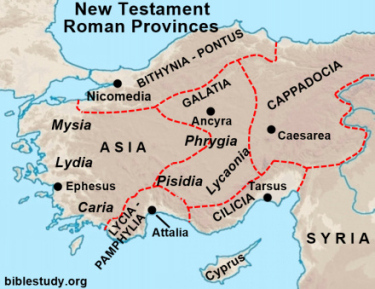Jews from Pontus (Bithynia) were among the many worshippers in Jerusalem on Pentecost in 30 A.D. when God poured out his spirit upon more than 3,000 people.
And they were all amazed, and marveled, saying to one another, "Behold, are not all these who are speaking Galileans? Then how is it that we hear each one in our own language in which we were born?
Parthians and Medes and Elamites, and those who inhabit Mesopotamia, and Judea and Cappadocia, Pontus and Asia . . . (Acts 2:7 - 9, HBFV throughout).
Pontus is the place where a Jew named Aquila, who later became a Christian along with his wife Priscilla, was born (Acts 18:1 - 2). The couple would become friends of the Apostle Paul and greatly aid his evangelistic efforts.

Forbidden to Preach
God, during Apostle Paul's second missionary journey, forbid him from preaching in or even entering Bithynia - Pontus.
And after passing through Phrygia and the region of Galatia (for they had been forbidden by the Holy Spirit to speak the word in Asia) They (Apostle Paul, Silas and Timothy) came down to Mysia and attempted to go to Bithynia; but the Spirit did not permit them to go there (Acts 16:6 - 7, HBFV).
One possible reason God did not allow Paul to preach in the province is that the Apostle Peter was already evangelizing the area (1Peter 1:1 - 2, see also Romans 15:19 - 20 and 2Corinthians 10:14 - 16). Peter addressed his first of two Biblical epistles to those in Bithynia - Pontus.
Later History
The popular study reference "The Life and Epistles of St. Paul," in its eighth chapter, states the following about Bithynia and its post-New Testament history.
"Stretching inland from the shores of the Propontis and Bosphorus, beyond the lakes near the cities of Nicaea and Nicomedia, to the upper ravines of the Sangarius, and the snowy range of Mount Olympus, it was a province rich in all the changes of beauty and grandeur . . .
"It was (Emperor) Hadrian's favorite province, and many monuments remain of that emperor's partiality . . ."
"The first great passage of its ecclesiastical history is found in the correspondence of (Roman Emperor) Trajan with its governor Pliny, concerning the persecution of the Christians. The second is the meeting of the first general council, when the Nicene Creed was drawn up on the banks of the Lake Ascanius."
Chalcedony is a precious stone found only once in the Bible (Revelation 21:19). It is believed to be named after the ancient Bithynian city of Chalcedon where it is found.